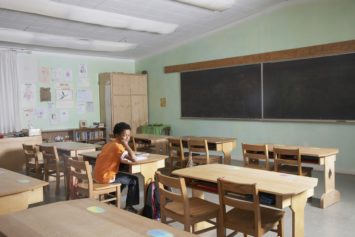
Jerimiah is not alone. This month NJ.com reported that another New Jersey school sent home nearly half of its students for trivial uniform violations. As more U.S. schools require uniforms, the number of students punished for failure to adhere to a school’s dress code — even in a minor fashion — has increased. African-American children and other children of color are most likely to be harmed by these policies.
While students at private, religious schools have worn uniforms for generations, uniforms at public schools are a relatively new trend. As crime increased in the late 1980s, schools began looking for new ways to keep students safe. Experts believed that uniforms would help curb gang activity and theft. In 1987, Baltimore and Washington, D.C., became the first districts to require uniforms for public school students. Since then, the movement has grown steadily. According to the U.S. Department of Education, the number of schools requiring uniforms has doubled since the 1999-2000 school year. In that year, only 11 percent of public schools mandated uniforms. By the 2015-2016 school year, 22 percent of public schools had switched to uniforms.
Although uniforms are common, they are more common in some areas than others. Generally, each school or school district can decide whether its students will wear uniforms But cities and schools with large African-American populations are more likely to adopt uniforms. The Atlanta Journal-Constitution reported that 75 percent of Atlanta’s public schools required uniforms. The numbers were far different in neighboring counties with larger white populations. Only 26 percent of schools in Cobb county required uniforms. In Gwinnett county, the number fell to 4 percent. The numbers are similar in cities such as New York and Chicago.
Schools present a variety of reasons for requiring uniforms. Many schools report that uniforms reduce student misbehavior. This was certainly the case in Long Beach, California. After Long Beach schools adopted uniforms in the mid-1990s, fights declined by 40 percent and grades improved. An Ohio study found that schools with uniforms had lower levels of suspensions, improved attendance, and higher graduation rates.
Dr. Scott Imberman, a professor of economics at Michigan State University, has written extensively about school uniforms. Dr. Imberman’s study of a large urban school district found that uniforms improved attendance, test scores, and behavior. Moreover, uniforms seemed to reduce the chance that students — particularly girls — would leave the district for a private or charter school.
While some research supports the use of uniforms, other studies cast doubt on their benefits. A study from Syracuse University found that uniforms barely increased academic achievement. A study from North Carolina found that non-uniform schools and uniform schools suspended students at the same rate. The study also found that the schools without uniforms had higher attendance. One leading study found that student scores dropped after uniforms were adopted. Clearly, the issue is not as clear-cut as some might think.
Beyond their effectiveness, uniforms present other issues for parents, teachers, and students. For many parents, cost is a key issue. Indeed, in an email interview with Atlanta Black Star, Dr. Imberman stated, “This is one of the biggest issues with uniforms – that low-income families in particular may struggle to pay for them. So, it’s important that schools that wish to adopt uniforms provide discounts, and possibly free uniforms, to students who are from low income families.” Some schools have developed programs to help parents cover the cost of uniforms. Others have an emergency closet for students in need. One New Jersey school even installed washers and dryers to help students keep their uniforms clean.
Perhaps the most serious issue posed by uniforms is school discipline. Like Jerimiah, students who fail to comply with the dress code can be sent home. Sometimes, students are punished more severely. For Black students, these punishments are no laughing matter because suspension is one of the first steps toward the school-to-prison pipeline.
African-American children are the primary targets of school discipline. Research from Columbia Law School found that Black male students were suspended three times more often than white males. The same study found that Black girls were six times more likely to be punished than white girls. Uniforms are one of the reasons for this difference.
When Black students are suspended, they are usually punished for a minor, subjective offenses such as “disobedience” or “failure to follow rules.” According to the American Bar Association, 95 percent of all school suspensions are of this type. Failure to wear the proper uniform falls in this category. Therefore, strict uniform policies can subject Black students to harsh discipline. Discipline can push the students out of school and into prison.
The connection between uniforms and the school-to-prison pipeline is real. In an email interview, Karen Dolan, director of the Criminalization of Race and Poverty Project at the Institute for Policy Studies, said, “Black girls, both cisgender and transgender, find their bodies are policed by uniforms and dress codes. They are policed for headscarves, hair wraps, restrictive clothing that doesn’t fit curvy bodies, as well as for hairstyles like natural styles, braids, locs, and twists. Black girls are seen by adults as more mature, more aggressive and hypersexualized and disciplined according to these false conceptions. Similarly, the adultification of Black boys also causes them to be disciplined more aggressively for any transgression, including a deviation from a dress code.”
One final issue complicates uniforms. While parents and teachers generally like uniforms, students generally do not. In one study, 75 percent of students opposed uniforms. Most objected because they felt uniforms restricted their personal freedom. Dolan agreed, stating, “Self-identity, self-expression, and exploration are necessary components of the maturation process and school uniforms by design prohibit this essential part of growing up.”
Uniforms seem to work best when parents, students, and teachers agree on the standards and how they should be enforced. Uniforms can be adopted in a way that avoids racism, sexism, and harsh discipline. Broward County, Florida, banned suspensions for all non-violent behaviors. There is a growing movement to make dress codes more fair by changing the policies that cause students to be punished. Perhaps these movements will succeed in making uniforms a good fit for all students.


